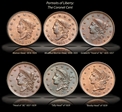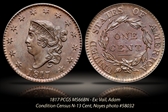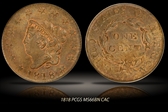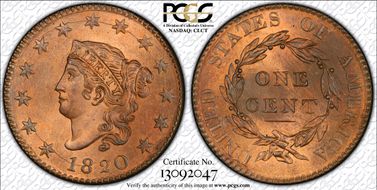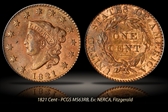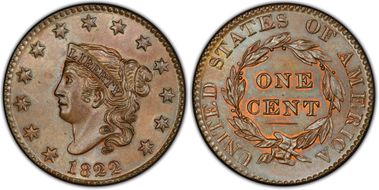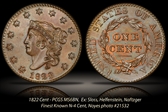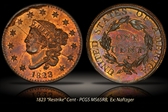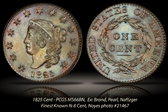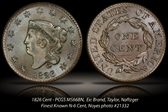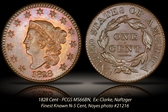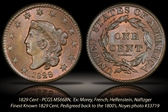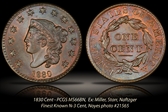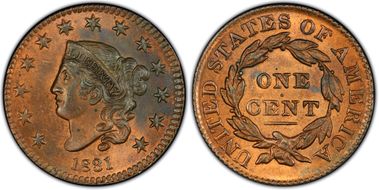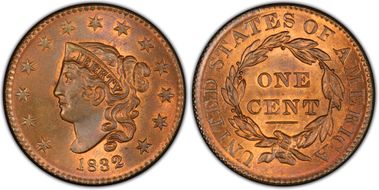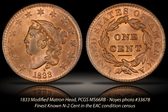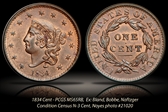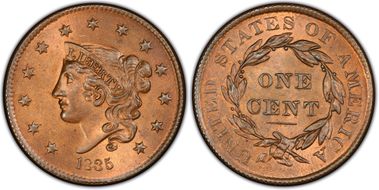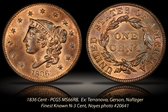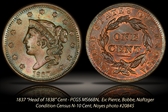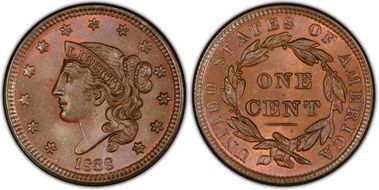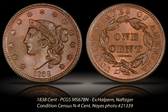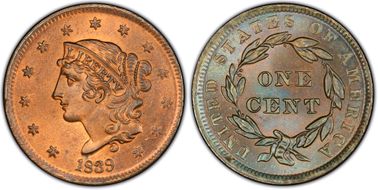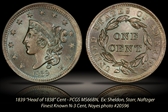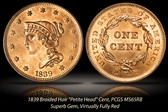Cardinal Collection 的钱币相册
Minted from 1816 to 1839, the "middle date" cents are all typically referred to as "Coronet Cents"; however, the portrait of Liberty did see several design modifications. Indeed, like the Classic Head cents before them, the Coronet cents had their detractors, who referred to the early Coronet designs as featuring the "obese ward boss." Perhaps, these snickering comments made their way back to the Mint, providing incentive for the design modifications. The earliest design, aptly called the "Matron Head," displays a matronly figure of liberty, mature and sophisticated. This subtype was produced from 1816 to 1829. From 1830 to 1835, the Matron Head design was gently modified to a somewhat more youthful look, with a tighter neck and more defined chin. Starting in 1835, Christian Gobrecht's artistic influences were seen throughout the full spectrum of American coinage, including a complete redesign of the Cent. The so-called Gobrecht "Head of '36" cent displays the new youthful Liberty with noticeably slimmer neck and still more defined chin, along with a total facial makeover. This design lasted from mid-1835 to mid-1837. The "Head of '38" cent came next, now displaying beaded hair cords to Liberty, in place of the previously plain cords. This design was featured from mid-1837 to early 1839. As the designs were being updated with greater speed, the Year 1839 witnessed no less than three distinctly different styles of the Coronet Cent (and the first Braided Hair Cents). 19th century coin dealer Ebenezer Locke Mason worked to sort these out, and in 1868 he described the distinguishing features of each, including two with rather colorful nicknames. The first of these colorfully-named 1839 cents features the addition of a hair curl at Liberty's forehead. Dubbed by Mason as the "Silly Head," the nickname has remained ever since. Finally, the Coronet cents experienced their last modification, exposing Liberty's shoulder between her flowing curls. Mason nicknamed this style as well, and henceforth it has been known as the "Booby Head." The collection includes each of these distinctive portraits of Liberty, including the transitional portrait varieties of each date, starting with 1816 N-7 cent (Noyes #21019).
Minted from 1816 to 1839, the "middle date" cents are all typically referred to as "Coronet Cents"; however, the portrait of Liberty did see several design modifications. Indeed, like the Classic Head cents before them, the Coronet cents had their detractors, who referred to the early Coronet designs as featuring the "obese ward boss." Perhaps, these snickering comments made their way back to the Mint, providing incentive for the design modifications. The earliest design, aptly called the "Matron Head," displays a matronly figure of liberty, mature and sophisticated. This subtype was produced from 1816 to 1829. From 1830 to 1835, the Matron Head design was gently modified to a somewhat more youthful look, with a tighter neck and more defined chin. Starting in 1835, Christian Gobrecht's artistic influences were seen throughout the full spectrum of American coinage, including a complete redesign of the Cent. The so-called Gobrecht "Head of '36" cent displays the new youthful Liberty with noticeably slimmer neck and still more defined chin, along with a total facial makeover. This design lasted from mid-1835 to mid-1837. The "Head of '38" cent came next, now displaying beaded hair cords to Liberty, in place of the previously plain cords. This design was featured from mid-1837 to early 1839. As the designs were being updated with greater speed, the Year 1839 witnessed no less than three distinctly different styles of the Coronet Cent (and the first Braided Hair Cents). 19th century coin dealer Ebenezer Locke Mason worked to sort these out, and in 1868 he described the distinguishing features of each, including two with rather colorful nicknames. The first of these colorfully-named 1839 cents features the addition of a hair curl at Liberty's forehead. Dubbed by Mason as the "Silly Head," the nickname has remained ever since. Finally, the Coronet cents experienced their last modification, exposing Liberty's shoulder between her flowing curls. Mason nicknamed this style as well, and henceforth it has been known as the "Booby Head." The collection includes each of these distinctive portraits of Liberty, including the transitional portrait varieties of each date, starting with 1816 N-7 cent (Noyes #21019).
N-2 Noyes #34514. Genuine 1823 cents were recognized very early on for their rarity, leading to the production of later "restrikes" using the discarded broken dies.
N-2 Noyes #34514. Genuine 1823 cents were recognized very early on for their rarity, leading to the production of later "restrikes" using the discarded broken dies.
N-4 Noyes #35711 as MS65 "Choice - virtually flawless." Tied as CC#1 in the EAC census with the Naftzer PCGS-MS66RB specimen.
1835 is the first of the transitional years for the middle date coronet cents. First is the "Head of 1834" portrait, represented by the N-1 cent (Noyes #56764), followed by the "Head of 1836" portrait, represented by the N-14 cent (Noyes #36392).
1835 is the first of the transitional years for the middle date coronet cents. First is the "Head of 1834" portrait, represented by the N-1 cent (Noyes #56764), followed by the "Head of 1836" portrait, represented by the N-14 cent (Noyes #36392).
1835 is the first of the transitional years for the middle date coronet cents. First is the "Head of 1834" portrait, represented by the N-1 cent (Noyes #56764), followed by the "Head of 1836" portrait, represented by the N-14 cent (Noyes #36392).
Another transitional year for middle date cents, the year 1837 witnessed the progression from the "Head of 1836" portrait style to the "Head of 1838" portrait, represented here by the N-7 cent (Noyes #21247) and the N-10 cent (Noyes #20845).
Another transitional year for middle date cents, the year 1837 witnessed the progression from the "Head of 1836" portrait style to the "Head of 1838" portrait, represented here by the N-7 cent (Noyes #21247) and the N-10 cent (Noyes #20845).
Another transitional year for middle date cents, the year 1837 witnessed the progression from the "Head of 1836" portrait style to the "Head of 1838" portrait, represented here by the N-7 cent (Noyes #21247) and the N-10 cent (Noyes #20845).
The Year 1839 was a very active one for the Mint's engravers, resulting in no less than three distinctly different styles of the Coronet Cent (and the first Braided Hair Cents). 19th century coin dealer Ebenezer Locke Mason described the distinguishing features of each, including two with rather colorful nicknames of "Silly Head" and "Booby Head." All four portrait styles are present in the collection, including the "Head of 1838" (N-3 Noyes #20596), the "Silly Head" (N-9 Noyes #20945), the "Booby Head" (N-11 Noyes #20819), and the Braided Hair "Head of 1840" (N-8, not in Noyes).
The Year 1839 was a very active one for the Mint's engravers, resulting in no less than three distinctly different styles of the Coronet Cent (and the first Braided Hair Cents). 19th century coin dealer Ebenezer Locke Mason described the distinguishing features of each, including two with rather colorful nicknames of "Silly Head" and "Booby Head." All four portrait styles are present in the collection, including the "Head of 1838" (N-3 Noyes #20596), the "Silly Head" (N-9 Noyes #20945), the "Booby Head" (N-11 Noyes #20819), and the Braided Hair "Head of 1840" (N-8, not in Noyes).
The Year 1839 was a very active one for the Mint's engravers, resulting in no less than three distinctly different styles of the Coronet Cent (and the first Braided Hair Cents). 19th century coin dealer Ebenezer Locke Mason described the distinguishing features of each, including two with rather colorful nicknames of "Silly Head" and "Booby Head." All four portrait styles are present in the collection, including the "Head of 1838" (N-3 Noyes #20596), the "Silly Head" (N-9 Noyes #20945), the "Booby Head" (N-11 Noyes #20819), and the Braided Hair "Head of 1840" (N-8, not in Noyes).
The Year 1839 was a very active one for the Mint's engravers, resulting in no less than three distinctly different styles of the Coronet Cent (and the first Braided Hair Cents). 19th century coin dealer Ebenezer Locke Mason described the distinguishing features of each, including two with rather colorful nicknames of "Silly Head" and "Booby Head." All four portrait styles are present in the collection, including the "Head of 1838" (N-3 Noyes #20596), the "Silly Head" (N-9 Noyes #20945), the "Booby Head" (N-11 Noyes #20819), and the Braided Hair "Head of 1840" (N-8, not in Noyes).
The Year 1839 was a very active one for the Mint's engravers, resulting in no less than three distinctly different styles of the Coronet Cent (and the first Braided Hair Cents). 19th century coin dealer Ebenezer Locke Mason described the distinguishing features of each, including two with rather colorful nicknames of "Silly Head" and "Booby Head." All four portrait styles are present in the collection, including the "Head of 1838" (N-3 Noyes #20596), the "Silly Head" (N-9 Noyes #20945), the "Booby Head" (N-11 Noyes #20819), and the Braided Hair "Head of 1840" (N-8, not in Noyes).
The Year 1839 was a very active one for the Mint's engravers, resulting in no less than three distinctly different styles of the Coronet Cent (and the first Braided Hair Cents). 19th century coin dealer Ebenezer Locke Mason described the distinguishing features of each, including two with rather colorful nicknames of "Silly Head" and "Booby Head." All four portrait styles are present in the collection, including the "Head of 1838" (N-3 Noyes #20596), the "Silly Head" (N-9 Noyes #20945), the "Booby Head" (N-11 Noyes #20819), and the Braided Hair "Head of 1840" (N-8, not in Noyes).




















